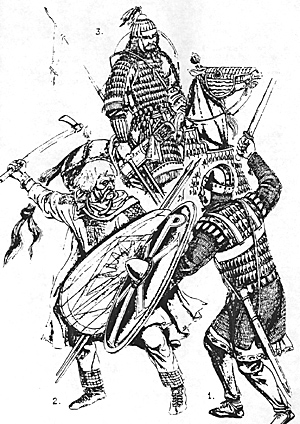 BYZANTIUM TRIUMPHANT
BYZANTIUM TRIUMPHANT
An event of great significance occurred during the sixth century in eastern Europe, areas north of the Black Sea, in the Balkans and along the lower course of the Duna river. Byzantium had achieved unprecedented military power, and had firmly re-established the territorial boundaries of the former Roman Empire. North Africa, Italy and other regions had come under the heel of Constantinople. The might of the "Second Rome" had even spread in ID the Crimea, Abkhazia and Armenia.
G. I. JUNIUS
Byzantine light infantry was armed with the light javelin, sling and poinard. They used powerful and resilient composite bows, (worn around the neck), and cylindrical quivers, (slung on the shoulder), which were of the same type as used by the Parthians and Huns Heavily armed warriors, both infantry and cavalry, were equipped with a long lance and sword. Armour consisted of large round or oval wooden shields covered with richly decorated hide and included a prominent iron boss. Riveted helmets with ear pieces and crest ridges were worn. Body armour consisted of chain mail, sometimes with a hood, lamellar constructed armour of pined metal strips, and scale armour.
THE SLAVIC MENACE
Numerous Slavic tribes impinging upon the area of the Lower Duna river presented a menacing threat to Byzantium in the sixth century. The imperial borders were penetrated in Thrace. Greece and throughout the Balkans by entire peoples and tribes of Slavs The empire organized punitive assaults in reaction, and even tried to recruit Slavs into the military service. These Slavs were notable for their size, strength, dexterity, endurance and bravery. Their weapons consisted of light javelins and spears, battle axes and short bows. Defensive armour consisted of large oval and small round wooden shields. In battle they wore long legged breeches and leather boots. (Translators note: these boots were moccasin in type and tied with thongs).
THE WRITHING ONES*
The greatest danger to both the Slavs and the Byzantines came from the steppes when the Turkish speaking Avar nomads swept from Central Asia into the area north of the Black Sea. They defeated the South Slavonic tribal groups and included them within their domain. Now Slavic infantry followed up by Avar cavalry fell upon Byzantium. The Avars introduced the stirrup into Europe and also brought a type of saddle with a high pommel, and a straight one edged blade which later developed into the saber. They used specially pointed spears and uniquely shaped cylindrical quivers containing long arrows and spare bow strings
*Note: The Avars were an offshoot of the Hiung-nu who began their expansion in the Gobi Desert area. The rulers of the area at that time, the Toba, regarded them as both dangerous and repulsive. They called them "Jouen Jouen", The Writhing Ones. As soon as they were flushed out they slithered away like snakes. They were unusually primitive. They could scarcely count let alone read. (Reference - The Barbarians of Asia by Stuart Legg, Dorset Press).
Back to Saga v6n3 Table of Contents
Back to Saga List of Issues
Back to MagWeb Master Magazine List
© Copyright 1992 by Terry Gore
This article appears in MagWeb (Magazine Web) on the Internet World Wide Web. Other articles covering military history and related topics are available at http://www.magweb.com